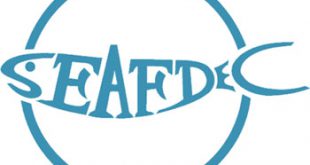


SEAFDEC/AQD added two commodities to its business package for entrepreneurs under the ABOT mechanism (Agree-build-operate-transfer AquaBusiness). These are pompano Trachinotus blochii and mangrove red snapper Lutjanus argentimaculatus whose hatchery, nursery and grow-out culture technologies are ready for commercialization.
AQD researchers Ms. Ofelia Reyes, Ms. Jocelyn Ladja and Mr. Eliseo Coniza presented these to stakeholders attending the Farmer’s forum on 11 July 2012 in Tigbauan, Iloilo as part of AQD’s 39th year celebration. They noted that the demand for high-value marine fishes like pompano (aka. apahan, damis lawin) and snapper (aka. managat, maya-maya, matangal bambangon) has been expanding as their market acceptance increased, and fishfarmers can profit from the high prices.
The hatchery requirements for pompano and red snapper are almost similar. Among others, this includes (a) hatchery area of 1,000 m2 with 3-5 ton larval tanks; (2) 50-150 pieces of broodstock; and (3) larval diet and/or live food for larvae and fry. Total investment in the hatchery can be around Php 800 thousand (cost of broodstock and maintenance are not included). With target production of 40- 50 thousand fry per crop, survival of 12-15%, and fry price of Php5-8 per piece (snapper is pricier than pompano), a hatchery operator can net Php 50-180 thousand per crop. Four crops are possible in a year. “Critical to success,” Ms. Reyes said, “are proper broodstock maintenance, availability of live food during larval rearing, and regular size-grading.”
AQD can provide training on marine fish hatchery. A five-week, hands-on course is on-going (26 June to 1 August) at AQD’s main station in Iloilo. The course is offered yearly.
Fingerling production of pompano and red snappers in ponds can be an enterprise separate from grow-out culture. Growing 1-inch size fry in netcages measuring 2 x 3 x 1.2 m3 in a small 0.5 ha pond, fishfarmers can produce the 45-60 g fish (body length, 4-5 inches) in 75-90 days. At a stocking density of 100-150 fry per m3 in 11-13 units of net cages, and with survival rate of 90-93%, the farmer can produce 10,000 snapper (4-inch body length, BL) and 7,800 pompano fingerlings (5-inch BL) which can be sold at PhP 20-24 each to grow-out farmers. Both fish need high protein diets of 46-48% (feed coversion ratio, 1.5). These feeds are commercially available in the market. The net profit per crop in a 0.5 ha pond is PhP 71 thousand and PhP 64 thousand for snappers and pompano, respectively. The farmer can have 3 crops per year. “In fingerling production of high-value fish,” Ms. Ladja said, “the use of shelters and size grading are important to prevent sibling cannibalism (in carnivorous fishes) and to produce uniformly-sized fingerlings.”
In grow-out culture of pompano and snapper in ponds (0.5-2 ha is suitable), there are two methods. One is direct stocking in the pond (5,000 fingerlings per ha using ≥20 g fish) and the other is stocking in net cages (density, 5 fish per m3; net mesh, 1.0-1.5 cm; cage size, 5 x 5 x 1.5 m at 40 units per ha or 10 x 10 x 1.5 m at 10 units per ha). The net cages are installed inside the pond with a water depth of ≥1.0 m. These cages occupy 10% of the pond area, and milkfish fingerlings (100-200 g) can be stocked (300-500 pcs per ha) outside the cages for added income.
Like all other grow-out pond ventures, fishfarmers must prepare the pond properly; select healthy, big and uniform-sized juveniles; practice proper handling, transport, acclimation and stocking; maintain good water quality; maintain the pond, cages and support facilities; do periodic sampling and monitor fish health; and harvest properly. Feeding pompano requires a diet with crude protein (CP) of 44-47% and crude fat (CF) of 12-18%; such feeds are commercially available. Snapper, on the other hand, need phased (starter, grower, finisher) diets with 48-50% CP and 12-15% CF. For the moment, these phased diets are prepared by SEAFDEC in small, experimental quantities. The use of phased diet would also enable the farmer to feed the right pellet size to fit the mouth of the fish and to give the feed formulation appropriate to the developmental stage of the fish.
“The cost of feed (61-66%) and juveniles (23-25%) are two highest variables in production cost,” said Mr. Coniza. “AQD produces its own pompano and red snapper grow-out diets, and our feed conversion ratio is 2.3 for pompano and 2.4-2.6 for snapper.”
Pompano and red snapper join the growing list of commodities with culture technologies. AQD also offers technology packages on giant freshwater prawn, abalone & seaweeds, mudcrab, grouper, milkfish, seabass, native catfish, tilapia and carp.
 SEAFDEC/AQD Southeast Asian Fisheries Development Center | Aquaculture Department
SEAFDEC/AQD Southeast Asian Fisheries Development Center | Aquaculture Department
